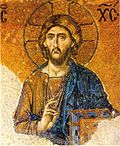- Nestorian Schism
-
Part of a series on Eastern Christianity 
History Orthodox Church History
Specific regions:
Byzantine Empire
Ecumenical council
Christianization of Bulgaria
Christianization of Kievan Rus'
East-West Schism
Asian Christianity
Coptic Egypt · UkraineTraditions Orthodox Church
Others:
Oriental Orthodoxy
Ethiopian Tewahedo Church
Coptic Church
Church of the East
Eastern Catholic Churches
Syriac ChristianityLiturgy and worship Sign of the cross
Divine Liturgy
Iconography
Asceticism
OmophorionTheology Hesychasm · Icon
Apophaticism
Filioque clause
Miaphysitism
Monophysitism
Diophysitism
Nestorianism
Theosis · Theoria
Phronema · Philokalia
Praxis · Theotokos
Hypostasis · Ousia
Essence vs. Energies
MetousiosisThe Nestorian Schism was the split between the Orthodox Church and churches affiliated with Nestorian doctrine in the 5th century. The schism rose out of a Christological dispute, the key figures in which were Cyril of Alexandria and Nestorius. Nestorius and his doctrine, which emphasized the distinctness between Christ's human and divine natures, were condemned at the First Council of Ephesus in 431 and the Council of Chalcedon. Afterward churches affiliated with Nestorius' teachings broke with the Orthodox church, thereby establishing Nestorianism as a distinct Christian sect. Nestorian doctrine was gradually adopted by the Church of the East, the Christian church of Sassanid Persia, which was thereafter often known as the Nestorian Church.
History
The doctrine of Nestorianism is associated with Nestorius, Patriarch of Constantinople 428 – 431. Prior to becoming Patriarch Nestorius had been a student of Theodore of Mopsuestia at the School of Antioch. Nestorius argued that Christ's human and divine natures were distinct, and was therefore against using the title Theotokos (Mother of God) for the Virgin Mary, instead preferring to call her Christotokos (Mother of Christ). Cyril of Alexandria considered Nestorius' doctrine to be contrary to Orthodox teaching, and encouraged measures to condemn it. Finally Nestorius and his doctrine were condemned at the First Council of Ephesus in 431, and the finding was reiterated at the Council of Chalcedon in 451.
Afterward churches aligned with Nestorius, centered around the School of Edessa, broke with the Orthodox Church, becoming an independent sect. Anathemized in the Roman Empire, they relocated to Sassanid Persia, where they were welcomed by Persian Christians who had already declared independence of Constantinople in an attempt to cast off accusations of foreign allegiance. The School of Edessa relocated to the Persian city of Nisibis (see School of Nisibis), thereafter a center of Nestorianism. In 484 the Sassanids executed the pro-Byzantine Catholicos Babowai and replaced him with the Nestorian Bishop of Nisibis Barsauma, effectively ending links between Persian Christianity and the Roman Empire. Thereafter Nestorianism spread widely through Asia, gaining a presence in India, Central Asia, the Mongol territories, and China. The medieval Nestorian movement survives in the Assyrian Church of the East, practiced most widely in Iran, Iraq, and Syria.
References
- O'Leary, De Lacy (2002). "Nestorian Schism". The Syriac Church and Fathers. Gorgias Press. ISBN 9781931956055.

This Eastern Orthodox Christianity-related article is a stub. You can help Wikipedia by expanding it.
